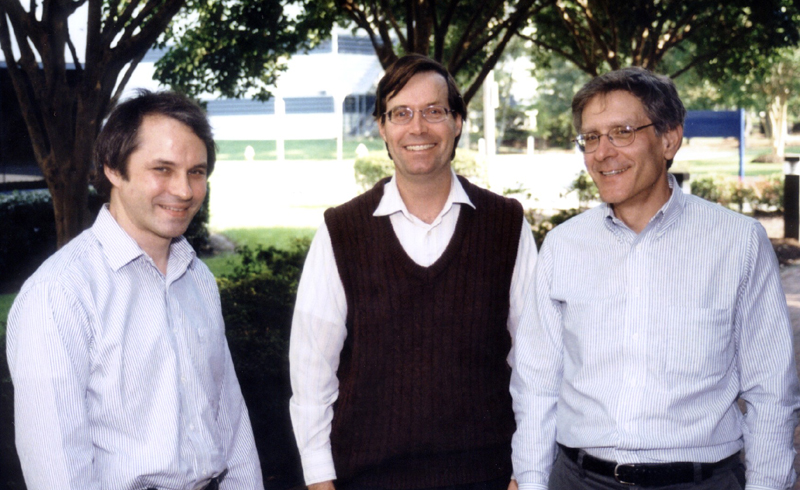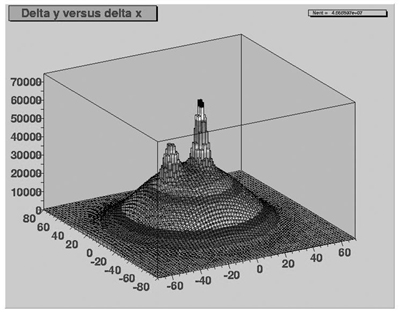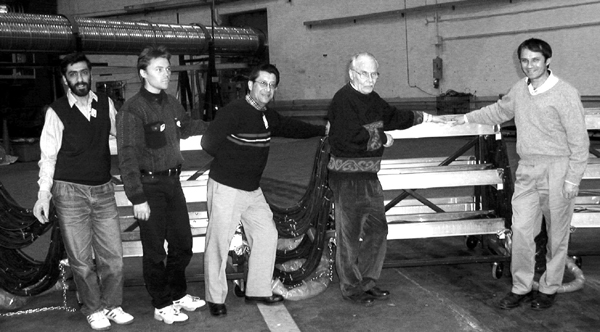
The Real Compton Scattering experiment spokespeople take a short break for a photo. From left is Bogdan Wojtsekhowski, JLab staff scientist; Charles Hyde-Wright, physics professor at Old Dominion University; and Alan Nathan, physics professor at the University of Illinois and chair of the JLab Users Group.
Jefferson Lab's Real Compton Scattering experiment explores the scattering of few-GeV photons off the proton at large scattering angles, under which conditions the quark structure of the proton is expected to be revealed best.
Jefferson Lab experiment E99-114 — the so-called Real Compton Scattering, or RCS, experiment — explores the scattering of few-GeV photons off the proton at large scattering angles, under which conditions the quark structure of the proton is expected to be revealed best. The experiment recently ended its data collection run, using one of Jefferson Lab's three experiment halls, located in Newport News, Virginia.
The collaboration of 85 physicists, representing 20 institutions spread across six countries, built, tested, installed and commissioned the specialized detectors needed to do this experiment, which ran from January to March 2002. Three spokespersons lead the team: Charles Hyde-Wright, physics professor at Old Dominion University; Alan Nathan, physics professor at the University of Illinois and chair of the JLab Users Group; and Bogdan Wojtsekhowski, JLab staff scientist.
"We seek to answer the question, 'How do high-energy photons interact with the proton when the photon scatters at a large angle?'" Wojtsekhowski explains.
"The experiment illustrates both the wave and particle nature of quarks inside the proton," adds Hyde-Wright. "We are testing whether in each scattering event, the photon bounces off a single quark in the way described by Compton for scattering from isolated electrons, and as predicted by Anatoly Radyushkin, who is both a professor at Old Dominion University and a member of JLab's Theory Group. Or does the scattering involve the cooperative behavior of three quarks, as predicted by pQCD?"

An RCS graph showing the kinematical correlation between the recoiled proton and the detected photon.
Design and construction for the experiment started in 1997, after it was approved by the Program Advisory Committee. "Jefferson Lab's stable, polarized beam gave us the tool we needed to do this experiment at a level of detail never before available," comments Nathan. Other specialized equipment for the experiment included a photon spectrometer built by the RCS collaboration, and a polarimeter for the protons, which was developed by a group of Hall A users from the College of William & Mary, Norfolk State University and Rutgers University. "The RCS experiment was made possible," Nathan points out, "because of the effective cooperation between JLab and its users."
A significant challenge for the researchers involved sifting through the millions of interactions taking place to identify the small number of relevant RCS events.
The experiment made two types of measurements. In the first measurement the scattering probability was surveyed over a wide range of scattering angles at four different photon beam energies. The manner in which the scattering probability depends on energy and angle, Wojtsekhowski explains, is very different in the two competing theories.
The second measurement concerned the direction of the spin — or polarization — of the recoiled proton. The Radyushkin theory predicts that the proton is polarized along the direction of its momentum, whereas the pQCD theory predicts that it is polarized in the opposite direction. The magnitude and direction of the polarization was measured in the experiment.

RCS collaborators move a cable rack into Hall A in preparation for Experiment E99-114. Lending a hand are (from left) Armen Ketikyan, Yerevan Physics Institute; Yuri Shestakov, Budker Institute of Nuclear Physics; Dimitri Margaziotis, California State University; Charles Perdrisat, William & Mary; and JLab's Bogdan Wojtsekhowski.
During a recent workshop at JLab the RCS collaboration presented preliminary results indicating that protons are polarized along their line of momentum, thereby providing confirmation that the single-quark scattering mechanism advocated by Radyushkin is dominant at this energy.
"After we complete our data analysis, we hope to have a significantly better understanding of the nature of Compton Scattering in the GeV energy range," explains Wojtsekhowski, who in 1995 conceived the concept of this high-accuracy experiment. "The productivity of our experiment was 1,200 times higher than the one run at Cornell in 1977. The high quality of JLab's continuous-wave beam allowed for the use of a mixed electron-photon beam."
"We are quite happy with the experiment's run," comments Hyde-Wright. "Nearly every item on the run plan was done according to the schedule. And the event rate was a few times higher than our expectations, which means our statistics should exceed expectations."
Full analysis of the experiment, which will be the subject of four Ph.D. theses, is expected to be complete in about two years.

